How many times have you finished a task and realized too late that you made a mistake?
It doesn't matter if that mistake was something you forgot to do or if you honestly didn't know that issue existed? Something wrong occurred that ruined your work.
Once, a long time ago before the interwebs, I had been living alone for quite some time, and I was hungry for chocolate chip cookies. I mean, who wouldn't be, right?
At that time, making cookie dough wasn't something I wanted to do, so I cheated and bought a tube of dough and sliced it like a loaf of bread.

So, I made the cookies, and after they cooled, I stared at a mound of cookie. What I didn't realize is that the cookies needed to cool down before stacking.
As I ate my chocolate chip cookie pie, I made a point to remember not to make that same mistake again.
Sometimes the best lesson in life is to burn a finger on a hot light bulb. Or in my case, baking a cookie mound.
Chocolate chip cookies and work surfaces have nothing in common with each other, but somewhere along the way, like me, somebody learned a lesson the hard way.
For me, it was cookies. For that unknown person, it was the need for edge banding.
Edge banding plays a vital role in the useful life of a work surface. However, until the advent of engineered wood in the last century, edge banding didn't exist.
It Needs to Start Somewhere

Quoting the Jimmy Castor Bunch in their song, Troglodyte:
What we're gonna do right here is go back, way back, back into time.
Before there were standing tables, desks, workbenches, and counters was the table. Several millennia ago, the Egyptians and Chinese each used a version of the table. Those early tables weren't used for eating.
Etymology
As tables evolved into the versions seen today, the etymology of the word evolved with it. The word itself comes from the combination of three languages: Latin, Old English, and Old French.
It's interesting because of the meaning of each version. The word describes "a piece of furniture with the flat top and legs."
The Table Through Time

The Egyptians started using stone tables to keep things off the floor. Eventually, they started elevating playing boards while finding a use for various smaller tables.
The Chinese, on the other hand, created early versions of the table for writing and the arts.
As time passed, the Romans and Greeks used tables in more ways, including eating. In the Middle Ages, not much was known about table usage; the only kinds described were ones used by the nobles.
Table Evolution
As the world became industrialized, tables transformed into critical accessories for nearly all industries. As manufacturing became standardized, wooden tables turned into metal.
When more people moved to office work, tables turned into desks. Those early versions were made from solid wood.
It became apparent that as the need for tables grew, it wasn't economical to keep using solid wood. Those desks were spartan in appearance but served its function. However, they weighed a ton!
Eventually, as technologies grew, manufactured wood became the material of choice.
A New Way of Seeing Things

On more than one occasion, I've been described as having an unusual mind. From seemingly nowhere, I'm able to pluck obscure facts about random things.
Know how I know when I've struck gold with insane trivia? When my wife responds with a sound I've come to know like the back of my hand.
Pfft!
With great power comes great responsibility, so I try to use my brain for good. One day I took a peek at the edge banding along the side of my desk. As the gears wound in my head, I wondered about the evolution of banding.
Specifically, what path did edge banding follow to reach this point?
Well, I found out.
Necessity, the Mother of Invention
As mentioned earlier, edge banding wasn't necessary for a long time. Tables, then desks, were made from solid materials such as rock, wood, and metal.
The idea of plywood reaches back to our friends the Egyptians and Chinese. The French and English worked with wood on a general principle of plywood, reportedly in the 17th and 18th centuries.
John K. Mayo developed the first patent for plywood in December 1865, but he never capitalized on his invention.
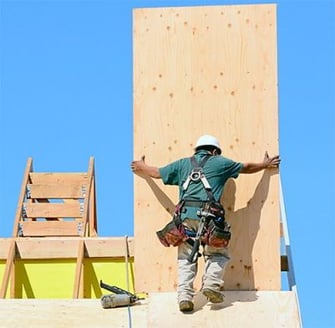
It wasn't until the 1905 World's Fair in Portland when a man named Gustav Carlson laminated wood panels from different types of softwoods and called it 3-ply veneer work.
Interest grew in the veneer work from the door, trunk, and cabinet manufacturers and the plywood industry took off.
The need for waterproof plywood resulted in Dr. James Nevin developing a fully waterproof adhesive.
For the engineered wood industry, the rest is history.
Well, except for edge banding. No, I didn't forget about it.
Are any of your desk accessories
listed in our top 5?
Stand up desk accessories make all the difference
in a productive environment and improve the benefits
you receive from your standing desk
Edge Banding: Hiding in Plain Sight
In our article about work surfaces, we explain how engineered wood is made. I'm not going to repeat the whole section, but share a portion that's relevant to this topic.
Modern Edge Banding
Until current applications, edge banding was manually applied using ordinary carpentry materials and tools.
As society progressed, the demand for furniture grew exponentially. Using solid pieces of wood was cost prohibited, so Carlson and Nevin's work came into its own in the high-volume, repetitive manufacturing industry.
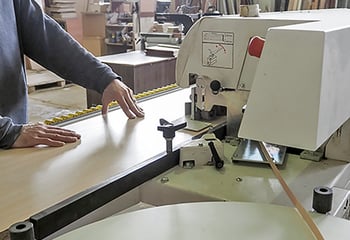
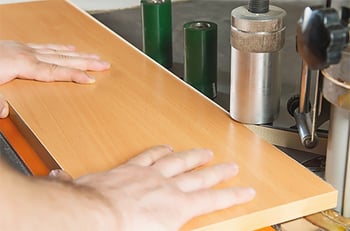
Many different materials went into the creation of plywood, particle board, and MDF. Because of that variety, creativity in edge banding became necessary.
Edge Banding Materials
As a review, the edges of engineered wood are ugly and rough. The jobs of edge banding are to give the appearance of a solid piece of wood and protecting the substrate from possible warping.
In a future post, we're going to rank the top five edge banding materials.
For now though, here's a brief overview of a few of the most common materials.
Polypropylene
Polypropylene (PUR) is fully recyclable, harmless, and odorless. Made completely from petroleum, PP is a neutral synthetic material.
PUR is rolled on at high temperatures, dries quickly, and cures to full strength within a few days. It's a strong glue that handles high and low temperatures, but determining its dry time is tricky. Despite that, PUR features moisture resistance up to 302 ºF
In addition to being the greenest banding, PP has several other advantages:
- Halogen-free
- Higher UV resistance to fading
- Very heat resistant
- Low shrinkage
ABS
Acrylonitrile butadiene styrene (ABS) is a thermoplastic polymer that's very popular and also a green material.
ABS reacts well to heat, and at higher temperatures, it's malleable and when cooled, becomes rigid.
Because it can be recycled, it's listed under the green category. If it's burned, the resulting gas isn't harmful.
PVC
Poly(vinyl chloride), or PVC, is the most commonly produced and least expensive plastics on earth. Technically a synthetic plastic polymer, its composition is flexible enough to be rolled into spools.
Although PVC can be recycled, the gas from burning is environmentally harmful. Decomposition also takes longer making PVC among the least green edging materials.
Melamine
Melamine is a special paper that's saturated and covered with lacquer. The addition of the lacquer adds resistance and strength to the paper.
- Not durable
- Best used where there's not a lot of traffic
- Despite the addition of lacquer, melamine is still paper
- Not waterproof
T-Molding
T-molding is an edge band material requiring a groove cut out in the substrate to fit the T-shaped edge band. It's a very tight fit so the T-molding needs to be lightly pounded into place.
Although T-molding looks relatively good when first applied, it doesn't last. Edges chip, obvious seams, and zero water resistance are the largest disadvantages from using T-molding.
Wood Veneer
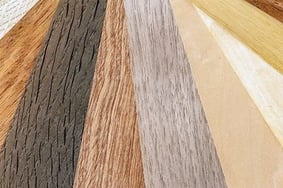
Wood veneer edge banding is made from thinly slices of wood, pre-sanded and layered. It can be both finished and unfinished depending on its application.
Wood veneer is available in oak, maple, mahogany, ash, and walnut, plus it's available in both pre-glued and glue-less versions.
Edge Banding Adhesives
Companies with a high-volume need for edge banding use an edge bander for applying adhesive to edge banding material to the substrate of work surfaces.
There are at least four methods of applying edge banding:
- Hot-melt glue
- Hot air/laser
- Iron-on
- Laser edging
Hot-Melt Glue Edge Banding
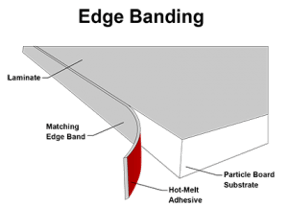
Hot-melt glue edge banding is the most common way manufacturers attach edge banding. Applying hot-melt glue requires cartridges or a glue pot.
The meaning of hot-melt glue edge banding is self-explanatory.
The adhesive on the edge band material is heated then applied to the edge of the laminate.
There are many types of adhesives used when applying edge banding. The following are the most common.
Hot Air/Laser Edge Banding
Applied heat to the back side of the edge band material creates a bond to the substrate. Because there's no glue involved, there's no glue line.
Referring to this method as 'hot-melt laser' is a misnomer. There's no actual laser used, but the name is a tribute to hot air achieving an invisible edge, just like a laser edge bander.
Visually, there's no difference between the hot air/laser process to laser edgebanding.
Iron-On
Iron-on edge banding doesn't require any specialized tools or skills. It's a simple, manual process where an iron attaches the edge banding material to the substrate.
After applying heat and pressure, the glue cools enough allowing a utility knife or chisel to trim excess material from the edge band.
Laser Edging
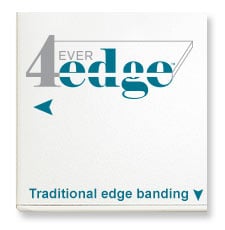
REHAU was the first North American supplier offering an adhesive-free laser edge banding option. Using a combination of a two-layer proprietary polypropylene and a laser creates a permanent, seam-free bond between the edge banding and the substrate.
Bill Knighton was an early advocate of hot air edge banding. Bill decided to feature the 4EVERedge™ as the standard for all RightAngle products.
Why?
The hot air method results in virtually invisible joins with a seam-free edge. The results increase the looks and protection of work surfaces and are fully recyclable, halogen-free, odorless, and neutral polypropylene material.
In Sum
What started as a stone surface thousands of years ago evolved into the work surfaces seen today.
As solid wood turned into engineered wood, the need to cover and protect edges progressed at the same time.
Something artisans spent time working with hand tools became less expensive for large production numbers.
Rather than being overlooked, edge banding became ubiquitous and a critical ingredient for quality work surfaces.

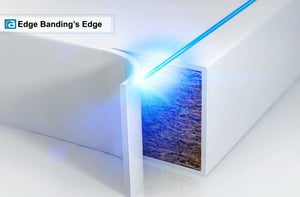
COMMENTS